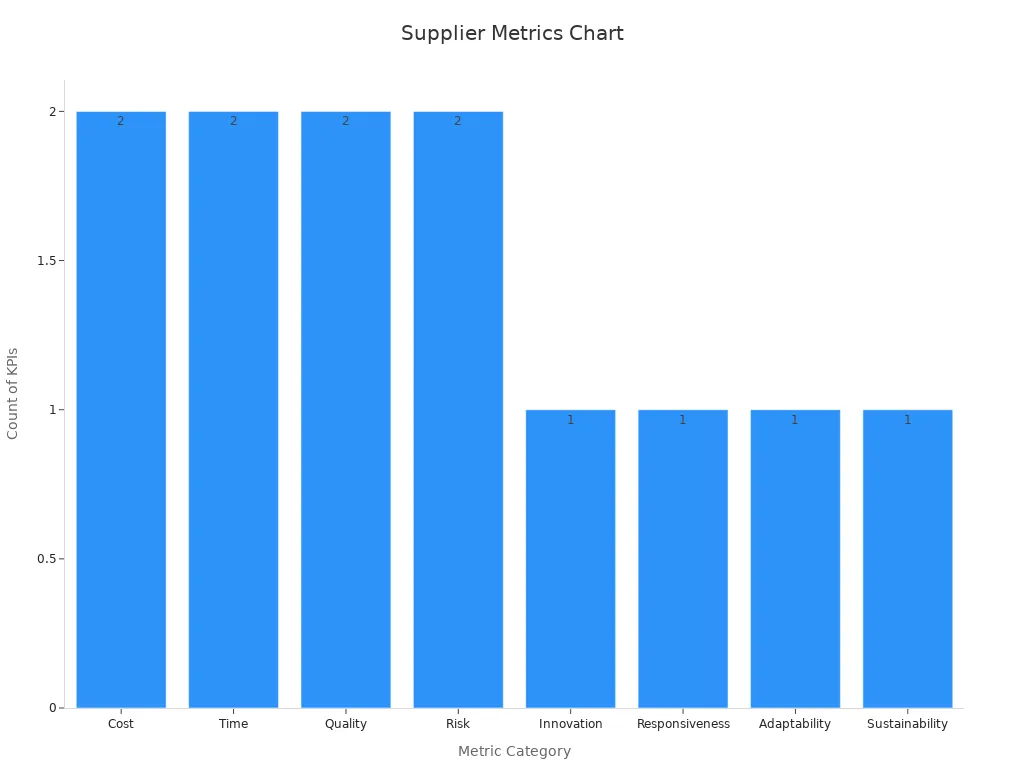
Sourcing hard to find electronic components in 2025 requires a strategic approach. The electronic components market continues to evolve, so buyers must act early and verify every source. Trusted suppliers help reduce risks in the electronic components market. They provide genuine parts and reliable access. Those who identify exact needs and use reputable sources can navigate the sourcing process more efficiently. With careful planning, anyone can successfully source even the rarest components.
Key Takeaways
-
Identify your exact component needs early to avoid shortages and overstocking during supply disruptions.
-
Always verify part details and check for alternatives to prevent quality issues and handle obsolescence.
-
Use trusted suppliers and global distributor networks to ensure genuine parts and reliable delivery.
-
Expand sourcing options by working with sourcing agents, brokers, and exploring surplus or international stock.
-
Implement strong inventory management and database tools to forecast demand and manage risks effectively.
Identify Component Needs
Understanding true component needs forms the foundation for successful sourcing, especially during a global chip shortage. Companies often struggle to predict demand accurately. Poor forecasting and the bullwhip effect can lead to overproduction or stockpiling, which distorts signals about actual component availability. A Gartner survey found that 68% of supply chain executives have faced major disruptions, highlighting the challenge of identifying real needs. Market research shows that firms rely on detailed analysis of trends and consumer behavior to align their component availability with shifting demand. Collaborative initiatives, such as unified demand forecasts across the supply chain, help clarify requirements and improve planning during component shortages.
Verify Part Details
Verifying part details ensures quality and compatibility, which is critical in the face of global chip shortage and shorter product life cycles. Data format and compatibility issues can cause duplications, inaccuracies, and even downtime.
-
These problems disrupt business operations and can lead to increased costs or reputational damage.
-
Diverse data standards and mismatched formats often cause gaps in reporting and operational delays.
-
Rigorous testing protocols, including Installation Qualification (IQ), Operational Qualification (OQ), and Performance Qualification (PQ), help validate accuracy and reliability.
-
Interoperability and load testing confirm that parts work together under different conditions, maintaining data integrity and product quality.
Tip: Always check calibration and maintenance records to ensure reliable performance and avoid costly disruptions.
Check Alternatives
Shorter product life cycles and the global chip shortage have increased the risk of obsolescence. In 2022, nearly 750,000 electronic parts reached end-of-life, with almost half-a-million more in 2023. This trend threatens component availability and can disrupt production. Companies that check for alternatives and use cross-reference alternatives during the selection process can avoid costly delays. Obsolescence management strategies, such as forecasting tools and backup plans, help maintain production and quality standards. These proactive steps ensure that when a specific part becomes unavailable, manufacturers can quickly adapt and maintain supply chain stability.
Sourcing Hard-to-Find Electronic Components
Trusted Suppliers
Trusted suppliers play a vital role in sourcing hard to find electronic components. Companies that use a global distributor network, such as Digi-Key, Mouser, or RS Components, benefit from reliable access to genuine parts. These distributors maintain strict quality standards and offer traceable supply chains. The electronic components market relies on measurable performance indicators to evaluate supplier reliability. The following table highlights key performance indicators (KPIs) that support the use of trusted suppliers:
| KPI | Benchmark/Target | Impact/Description |
|---|---|---|
| Supplier Acquisition Rate | > 70% | Expands component variety and supply base. |
| Supplier Retention Rate | > 80% | Ensures consistent inventory and reliability. |
| Supplier Satisfaction Score | Up to 25% improvement | Enhances supplier relationships and operational improvements. |
| Quality Assurance Metrics | < 1% defect rate | Reduces defects and returns, ensuring high quality. |
| Rate of Defective/Returned Items | Decrease by 15% | Improves quality control and reduces disruptions. |
| Supplier Compliance with Standards | 95%+ adherence | Maintains trust through quality and operational standards. |
| On-time Delivery | High percentage | Minimizes production delays. |
Companies that source hard-to-find electronic components from trusted suppliers reduce the risk of counterfeits and ensure consistent quality. Regular monitoring of supplier performance, including on-time delivery and defect rates, helps maintain high standards. A global distributor network also supports sourcing critical components during shortages in the electronic components market.
Note: Implementing incoming inspection and testing procedures upon receipt of components helps detect quality issues early and ensures only compliant parts enter production.
Online Marketplaces
Online marketplaces have become essential online resources for sourcing hard to find electronic components. Platforms like Digi-Key, Mouser, and RS Components connect buyers to a global distributor network and offer a wide selection of parts. These marketplaces provide authentic and traceable components, which is crucial in the electronic components market.
-
Digi-Key receives praise for strong customer support and stock availability. Some users note higher prices but appreciate discounts for large orders. Concerns have emerged about recent website changes and the introduction of marketplace vendors, which may affect component authenticity.
-
Mouser stands out for its reliable service and user-friendly website, especially in Europe. Users value its convenient warehouse locations and efficient parametric search features.
-
RS Components is less frequently mentioned but maintains a reputation for reliability.
Buyers should avoid unverified suppliers on marketplaces to reduce the risk of counterfeit parts. Online communities and forums offer valuable peer advice for sourcing electronic components and navigating the electronic components market. These resources help users identify reputable sources and share experiences with hard-to-find electronic components.
Expand Sourcing Options
Sourcing Rare Electronic Components
Companies often face challenges when they need to source hard to find electronic components, especially as the electronic components market grows more complex. Sourcing rare electronic components requires a flexible approach. Many organizations expand their supplier network to include surplus stock, operational equipment, and international suppliers. This strategy increases the chances of finding discontinued or limited-availability parts.
Research highlights several benefits when companies expand their supplier network and sourcing options:
-
Strong supplier relationships give priority access to scarce parts and reduce disruptions. A survey from the Institute for Supply Management found that 67% of companies with these relationships had better business continuity.
-
Authorized distributors and brokers improve availability and reliability. The Electronic Components Industry Association reported higher satisfaction rates among companies using these channels.
-
Robust inventory management systems lead to better order fulfillment and lower costs. A McKinsey & Company study showed up to 20% cost reduction and a 50% improvement in fulfillment rates.
-
Flexible design and alternative components boost supply chain resilience. Research and Engineering Design found over 10% improvement in economic lifecycle performance with flexible design.
Tip: Companies that explore surplus inventories and international sources often find rare parts that are unavailable through standard channels.
Sourcing Agents and Brokers
Sourcing rare electronic components sometimes requires professional help. Sourcing agents and brokers specialize in locating obsolete or end-of-life parts. They maintain connections across the electronic components market and can quickly identify available stock.
-
In the aerospace industry, a manufacturer avoided a $2 million loss and a six-month delay by working with a specialized distributor to secure a discontinued microcontroller.
-
Consumer electronics companies responded to global shortages by expanding sourcing networks and collaborating with distributors to secure multilayer ceramic capacitors.
-
Experts recommend working with trusted, certified distributors, multisourcing, and proactive planning to forecast obsolescence.
Sourcing agents and brokers help companies source hard to find electronic components, maintain production schedules, and reduce risks. Their expertise and networks make them valuable partners in the electronic components market.
Use Sourcing Tools

Inventory Management
Effective inventory management forms the backbone of reliable electronic component sourcing. Companies that use best practices in inventory management can reduce the risk of shortages and maintain high availability of critical parts. Supply Chain Risk Management Systems (SCRMs) help teams monitor demand in real time and create surplus inventory buffers. These systems identify demand surges and support forecasting, which helps avoid both overstocking and understocking.
-
Just-in-Case (JIC) inventory buffers keep extra stock on hand, ensuring continuity during unexpected disruptions.
-
Analytical models, such as Bayesian networks, support risk assessment and decision-making.
-
Digital technologies like barcode tracking and predictive analytics improve inventory accuracy and timely replenishment.
-
Balancing lean inventory with resilience-focused strategies helps organizations maintain supply continuity and control costs.
A 2023 CNBC report showed that advanced sourcing tools, including predictive analytics and digital procurement platforms, optimized maintenance costs by 75%. These tools reduce human error and increase operational efficiency. Companies that invest in these solutions improve procurement workflows, enhance transparency, and respond quickly to market changes. This approach supports both quality and availability, even during supply chain disruptions.
Tip: Poor inventory management can lead to costly overstocking or dangerous shortages. Real-time tracking and flexible strategies help maintain quality and availability.
Database Software
Component database software plays a crucial role in planning for obsolescence and ensuring ongoing availability. These tools allow teams to anticipate lifecycle risks before they affect production. Accurate data supports forecasting and business strategies throughout the product lifecycle. Database software generates targeted alerts for Product Change Notices (PCNs) and helps procurement teams make informed decisions about last time buys or lifetime buys.
-
Teams can estimate current and future demand to avoid over- or under-purchasing.
-
Forecasting considers production, sales, sustainment, and failure rates.
-
The software manages cost impacts, including inventory holding and disposal.
-
Proactive obsolescence management reduces downtime and redesign costs.
-
Communication and coordination improve among personnel involved in risk mitigation.
A structured approach to obsolescence management includes identifying all technology assets, assessing their lifecycle stage, and defining business criticality. Teams evaluate risks, plan mitigation strategies, and monitor vendor roadmaps. Enterprise architecture tools automate inventory and risk assessment, supporting quality and availability across the supply chain.
Note: Reliable database software enables procurement teams to stay ahead of supplier disruptions and maintain high quality standards.
Build Supplier Relationships
Long-Term Partnerships
Strong, long-term partnerships with distributors, brokers, and international suppliers form the backbone of a resilient global distributor network. Companies that invest in these relationships see measurable improvements in reliability and efficiency. The Supplier Performance Score, or Supplier Scorecard, combines key metrics such as on-time delivery, responsiveness, product quality, and lead time accuracy. This score helps companies identify high-performing suppliers who support customer demands and maintain efficient supply chains.
| Metric Category | Specific Metrics / KPIs | Impact on Supply Chain Performance |
|---|---|---|
| Cost | Cost Variance, Total Cost of Ownership | Ensures financial efficiency and cost-effectiveness |
| Time | On-Time Delivery Rate, Lead Time | Improves delivery reliability and reduces lead times |
| Quality | Defect Rate, Compliance with Specifications | Enhances product consistency and reduces defects |
| Risk | Supplier Risk Score, Incident Frequency | Mitigates supply disruptions and financial/geopolitical risks |
| Innovation | Contribution to Innovation | Drives new product/process improvements and competitive advantage |
| Responsiveness | Response Time to inquiries and issues | Maintains business continuity and quick problem resolution |
| Adaptability | Ability to adjust to demand/spec changes | Increases supply chain agility and resilience |
| Sustainability | Sustainability Practices | Supports environmental and social responsibility compliance |
Companies that monitor these metrics can quickly spot issues and work with their global distributor network to resolve them. Low defect rates and high compliance with specifications reduce costly returns and recalls. High responsiveness and adaptability help companies react to market changes and supply chain disruptions.

Tip: Regularly reviewing supplier scorecards helps companies maintain high standards and strengthen their global distributor network.
Supply Chain Resilience
Supply chain resilience depends on more than just strong partnerships. Companies use strategies like diversification and reshoring to protect against supply chain disruptions. Diversification spreads risk by using multiple suppliers and regions. The "country plus-one" approach allows companies to quickly shift sourcing if one region faces problems. Reshoring and nearshoring bring production closer to home, which shortens lead times and reduces exposure to geopolitical risks.
Industry research shows that over half of manufacturing firms now use dual sourcing or multi-sourcing. These strategies help companies maintain business continuity and balance cost with innovation. Flexible contracts and inventory reserves also act as buffers during disruptions. Data-driven tools and Industry 4.0 technologies give companies better visibility, allowing for dynamic sourcing decisions and faster responses.
Note: Building a global distributor network and using flexible sourcing strategies help companies stay agile and competitive, even during unexpected supply chain disruptions.
Sourcing hard-to-find electronic components in 2025 requires clear planning, reliable suppliers, and strong supply chain management. Companies that invest in localization and R&D see measurable results. For example:
| Sector / Component | Market Share or Localization Outcome | Timeframe |
|---|---|---|
| Luminescent detection IVD | Market share rose from 10% to 25% | 2015 to 2021 |
| Carbon fiber | Localization rate increased from 18% to 47% | 2015 to 2021 |
| Fiber lasers | Localization rate surged from 29% to 65% | 2017 to 2021 |
These improvements show that proactive strategies help companies overcome sourcing challenges. Applying these steps leads to reliable and efficient sourcing, even as technology and markets evolve.
FAQ
What are the main risks of buying electronic components from unverified sources?
Unverified sources often sell counterfeit or substandard parts. These components may fail quality checks or cause device malfunctions. Trusted suppliers reduce these risks by providing genuine, traceable products.
How can companies check if a component is obsolete?
Companies use component database software to track lifecycle status. These tools send alerts for end-of-life notices and help teams plan replacements. Regular checks keep production lines running smoothly.
Why do companies use sourcing agents for rare components?
Sourcing agents have access to global networks and specialized contacts. They locate hard-to-find or obsolete parts quickly. Their expertise helps companies avoid production delays and costly redesigns.
What is the benefit of using inventory management systems?
Inventory management systems track stock levels in real time. They help prevent shortages and overstocking. These systems also support accurate forecasting and improve supply chain efficiency.
Can online forums help with sourcing electronic components?
Yes. Online forums connect buyers with industry peers. Users share supplier reviews, sourcing tips, and warnings about counterfeit risks. These communities offer valuable advice for finding reliable parts.
Written by Jack from AIChipLink.
AIChipLink, one of the fastest-growing global independent electronic components distributors in the world, offers millions of products from thousands of manufacturers, and many of our in-stock parts is available to ship same day.
We mainly source and distribute integrated circuit (IC) products of brands such as Broadcom, Microchip, Texas Instruments, Infineon, NXP, Analog Devices, Qualcomm, Intel, etc., which are widely used in communication & network, telecom, industrial control, new energy and automotive electronics.
Empowered by AI, Linked to the Future. Get started on AIChipLink.com and submit your RFQ online today!














